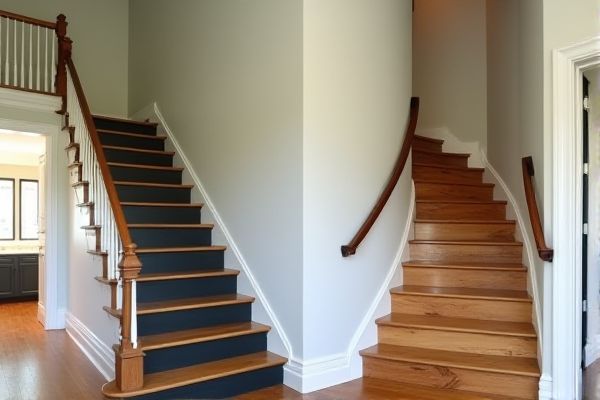
Painted stairs offer a bold, uniform look that can easily match various interior styles, while stained stairs showcase the natural wood grain for a timeless, authentic appearance. Explore the rest of the article to discover which option best suits your home's aesthetic and maintenance preferences.
Table of Comparison
| Feature | Painted Stairs | Stained Stairs |
|---|---|---|
| Appearance | Opaque, uniform color | Transparent, highlights wood grain |
| Durability | Resistant to scratches, chips over time | Penetrates wood, durable but can wear |
| Maintenance | Easier to clean, touch-ups may show | Requires periodic reapplication to maintain look |
| Cost | Generally lower cost | Typically higher cost due to materials and labor |
| Style | Modern, bold colors available | Classic, natural wood aesthetics |
| Installation Time | Faster application and drying | Longer process including sanding and sealing |
Introduction to Painted vs Stained Stairs
Painted stairs offer a solid, uniform color that can brighten spaces and match any interior style, providing excellent coverage over wood imperfections. Stained stairs highlight the natural grain and texture of the wood, enhancing warmth and character while preserving the material's organic beauty. Choosing between painted and stained stairs depends on desired aesthetics, durability, and maintenance preferences for each specific home environment.
Aesthetic Differences Between Painted and Stained Stairs
Painted stairs offer a solid, uniform color that can brighten spaces and complement modern or minimalist decor, while stained stairs showcase the natural wood grain, enhancing warmth and organic texture in traditional or rustic interiors. The paint creates a smooth, opaque finish that conceals wood imperfections, whereas stain penetrates wood fibers, highlighting knots and character marks for a more authentic look. Choosing between painted and stained stairs depends on the desired visual impact, with paint providing vibrant color options and stain delivering timeless elegance through natural wood tones.
Durability and Maintenance Comparison
Painted stairs offer a durable surface with resistance to moisture and wear but may show scratches and chips more visibly, requiring regular touch-ups for maintenance. Stained stairs highlight the natural wood grain and aged gracefully with wear, often needing periodic reapplication of sealant to protect against scratches and moisture damage. Both options require proper finishing and upkeep, but stains typically demand less frequent maintenance than painted finishes.
Cost Analysis: Painting vs Staining Stairs
Painting stairs typically costs between $1 and $3 per square foot, depending on the type of paint and labor, while staining stairs ranges from $2 to $5 per square foot due to the preparation and sealing required. Paint offers a lower upfront cost but may need more frequent touch-ups or repainting over time, increasing long-term expenses. Staining provides a durable finish with natural wood aesthetics that can enhance home value, often justifying the higher initial investment.
Suitability for Different Wood Types
Painted stairs are ideal for softwoods like pine or MDF, as the opaque finish hides imperfections and grain inconsistencies, providing a smooth, uniform appearance. Stained stairs suit hardwoods such as oak, maple, or cherry, enhancing the natural grain patterns and preserving the wood's character with a transparent, enriching finish. The choice between painted and stained stairs largely depends on the wood type, desired aesthetic, and durability requirements.
Impact on Home Value and Style
Painted stairs can significantly enhance modern or contemporary home styles, offering a clean and customizable look that appeals to many buyers, thereby potentially increasing your home's market value. Stained stairs highlight the natural wood grain, adding warmth and timeless elegance favored in traditional or rustic interiors, which can attract buyers seeking classic craftsmanship. Choosing between painted or stained stairs ultimately influences your home's style statement and resale appeal by aligning with the preferences of your target market.
Step-by-Step Application Processes
Painted stairs require cleaning, sanding, priming, and applying multiple coats of high-quality paint with drying time between each step to ensure a smooth, durable finish. Stained stairs involve sanding to remove old finish, applying wood conditioner if needed, staining with your chosen color evenly, then sealing with a clear polyurethane to protect the wood grain. Both methods demand careful surface preparation and proper drying time to achieve optimal long-lasting results.
Popular Design Trends for Painted and Stained Stairs
Popular design trends for painted stairs emphasize bold, solid colors like navy blue, charcoal gray, or classic white, offering a modern and clean aesthetic. Stained stairs showcase natural wood grains with warm tones such as walnut, cherry, or oak, creating a timeless and elegant feel. Your choice between painted and stained stairs influences the overall ambiance, with painted stairs providing a sleek, contemporary look and stained stairs enhancing rustic or traditional interiors.
Pros and Cons of Painting Stairs
Painting stairs offers a wide range of color choices and allows for easy customization, making it ideal for achieving a specific design aesthetic or brightening up dark spaces. It provides a protective layer that resists moisture and wear, but painted surfaces are prone to chipping and require regular maintenance to keep their appearance pristine. Compared to staining, painted stairs can sometimes feel less natural and may hide the wood grain, impacting the organic look of hardwood steps.
Pros and Cons of Staining Stairs
Staining stairs enhances the natural wood grain, offering a rich, warm appearance that highlights the texture and character of the wood. It provides durability and resistance to wear without concealing imperfections, making it ideal for high-traffic areas. However, stained stairs may require regular maintenance and refinishing over time to preserve their aesthetic and protect against moisture damage.
 homyna.com
homyna.com